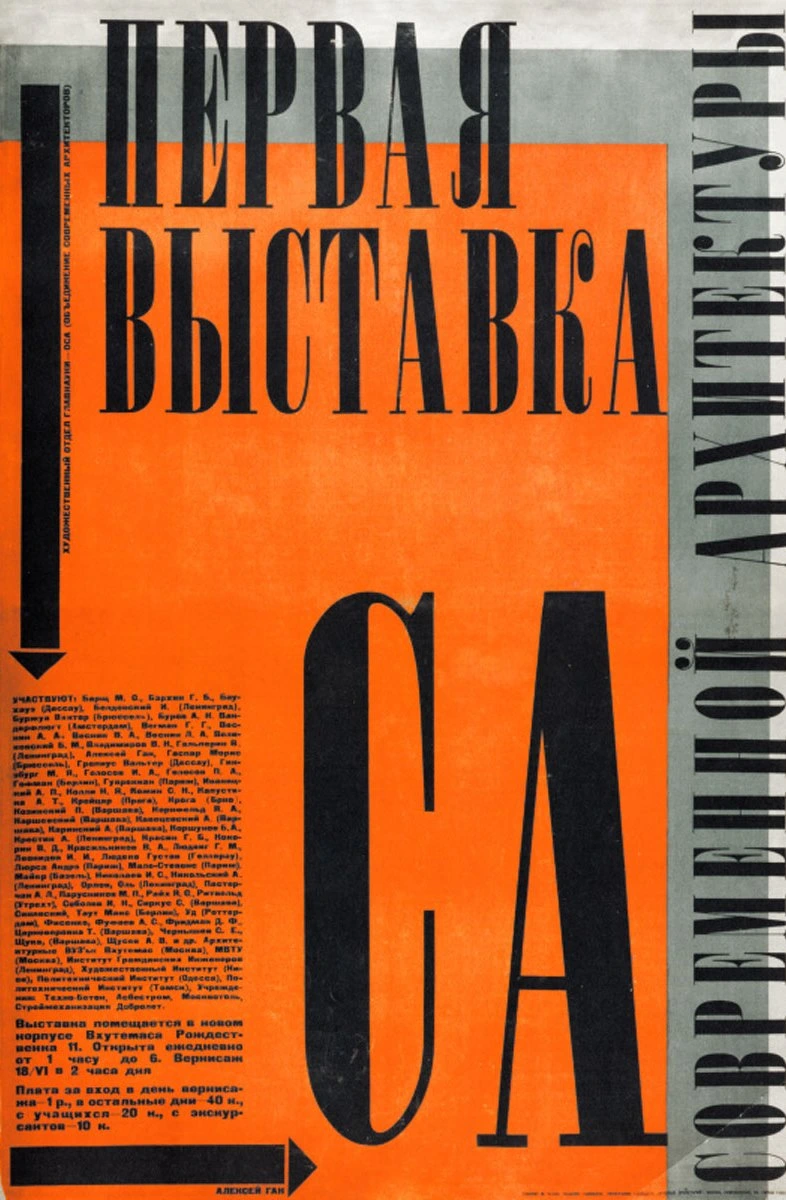before the great war
Since his days as an anarchist youth Gan had a habit of hiding personal details of his life even from close friends, thus relatively little is known of his biography. Even his date of birth is uncertain—some claim 1893, others 1895, while most researchers have agreed on 1897. However, it is known that he was born to a family of Russian gentry of French origin, Mikhail Imberkh, and had five siblings.
According to Kristin Romberg, author of an influential thesis on Gan, in the early 1910’s he received an artistic education and later joined an underground anarchist movement, acting and singing in theaters as a cover.

Cover of Long Live to Demonstration of Living book written and designed by Aleksei Gan, 1923.
[in design] there should be nothing random, uncontrolled, nothing based only on blind taste and aesthetic voluntarism. everything should be thought through, both technically and functionally. —aleksei gan

Poster dedicated to the First Exhibition of Modern Architecture designed by Aleksei Gan, 1927.
first world war and revolution
Despite his anarchist political inclinations, Gan served in World War I, where he suffered a severe concussion. After the October Revolution he began working with an organization called Moscow Federation of Anarchist Groups. However, as anarchists started losing leverage in communist Russia, Gan drifted towards Bolshevism. Later, in 1918, all Soviet anarchist organizations were crushed by the Bolsheviks and banned until the end of the 1980’s. Gan’s anarchist links became a liability, and eventually may have cost him his life.


Esfir Shub.
In Alexander Rodchenko’s studio. From left to right: Alexander Rodchenko, Aleksei Gan, Evgenia Sokolova-Zhemchuzhnaya, Olga Rodchenko, Esfir Shub, and Varvara Stepanova. 1924. Photo from private collection.
typography was a field that the constructivists innovated, and for which they are famous for. the effects can still be widely seen today. —eleanor rees, poet and critic

Back cover of SA magazine, issues 5–6, 1926.
mass action as proto-constructivism
One of the art forms that preceded and influenced Constructivism was mass actions—a highly orchestrated form of happening associated with Bolshevism, which began in 1918. Mass actions included, for instance, a reenactment of Revolution Night staged by thousands of actors, directed in Saint-Petersburg in 1920 by Nikolai Evreinov. Gan directed mass actions from 1918 to 1920 in Moscow. His ideas were radical, such as coordinating the entire population of Moscow to perform in the May Day spectacle.
Mass action gradually became a cornerstone of Gan’s theoretical work, earning him the title “constructor of mass action.” This was somewhat ironic, as the practicality of mass actions steadily decreased throughout the 1920’s due to the intensifying political climate.


best known as co-founder of the first working group of constructivists and author of the group’s agitational and theoretical texts, gan's own oeuvre was comprised of amateur performances and mass-media objects (texts, books, journals, and films). —kristin romberg, soviet art historian